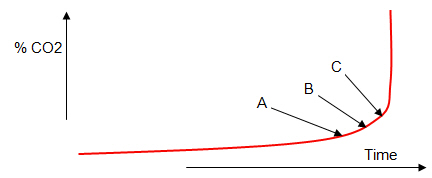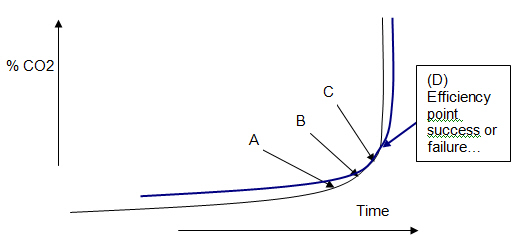

The current climate effects, the heatwaves, droughts, floods across the word in every continent and with such severity and repetition amaze us. Today, people have come to expect them; as they have grown in intensity gradually over the last 20 to 30 years.
But imagine if you can, that you are back in the 1970’s where massive natural disasters around the world were few and far between. To suddenly see all of 2022’s worldwide climate disasters appear in 1972 would have seemed totally crazy. Viewing all these destructive events fifty years ago would have made us then extremely frightened. We would have seen them for what they are, massive global changes that indicate a future major catastrophe for the planet and human kind. Today we just take them for granted, but we should now still be very frightened.
The discussion now is about where we are on the climate change curve:

The media and scientific community tell us we are at point (A). They do this because they wish us to concentrate on climate change prevention issues. Many scientists and others believe worldwide data and the real-world changes tell us we are already past this point (A), and approaching (B) where the climate has already changed irrevocably with some major tipping points having been breached, with no possible return to the previous state. These tipping points include the positive feedback system between the Russian Tundra and the Arctic ice melt, the Amazon rain deforestation which has now reached it’s sustainability limit, the Arctic & Antarctic ice shelves on course for collapsing causing rising sea levels and changes to major sea currents.
One major tipping point almost ceartainly breached today is the feedback between the melting artic and the Russian Tundra melt - producing a massive amount of methane - the worst 'climate change gas'. This will not only scupper ANY human attempt to prevent further warming, but is likley to be so drastic that the world warms very fast - watch out!
CST thinks we are also at (B). Maybe even approaching (C). If so, then the straight line after point (C) is the exponential change due to the positive feedback from a number of global tipping points kicking in. The point here is that each tipping point will reinforce the others and then we get a very fast runaway impact that includes sea level rise, major sea flows changing & warming seas leading to massive changes to the world’s metrology. No one has any idea what then occurs. From what we have already seen, we can expect ongoing massive weather disruption. What are the timescales? The media keep presenting the end of the century as the timescale for this potential (C) scenario, (if we miss the preventative goals). But, this is a ‘nice’ timescale as humans don’t care a hoot about something they feel they will never personally encounter. CST believes this is now an outrageous lie by the scientfic and political community to keep us in the dark.
The End Game:
If we are indeed approaching (C), these continous massive climate impacts could start to happen in say in 5 to 30 years.
"Such a timescale means we may soon be approaching a global economic catastrophe due to global economics"
We need to understand that "global economics" just describes ‘human work efficiencies’. As toolmakers, humans alone have created an age where one person’s output is multiplied by our ‘tool efficiencies’. Today, one person’s economic output is multiplied up to 1000 times that of one hundred years ago, when the most significant efficiency tool was animal power and the early steam engine. Today’s infrastructure and tools (road / rail / energy / shipping / communications / robotics) creates an immense multiplier for many people’s work outputs. Globally, we have seen massive surpluses of ‘wealth’ (surplus work output). While these have gone to the rich and powerful in the main, they have lifted the industrialised nations from poverty and subsistent living. Most people think that this is now the status quo and will continue, CST does not.
When we hit the climate change exponential rise (near vertical line), some years after (C), the nations of the world will have to deal with massive climate disruption on an ever increasing scale. We have just seen Pakistan lose a third of its housing due to flooding, the impact of this is economically significant for the foreseeable future. Pakistan will need to use more of its total output to rebuild the lost infrastructure. This means that overall living standards for the average Pakistani will fall. If they are hit again by other major climate crisis, before they can rebuild fully, it is obvious that a continuing decline in living standards becomes inevitable.
When the industrialised nations (US, Europe, Japan, Canada, Australia, China, S. Korea) hit the exponential climate change curve, they too will be seriously affected by increasingly destructive climate effects such as floods, storms, sea rise, earthquakes & drought. This in turn will also lead directly to continuous global food shortages.
Currently these industrialised nations have the economic efficiency to weather present conditions as they create surplus wealth. But as the destruction is multiplied many times, and nations are being hit every week, maybe daily, by serious floods, storms et al, then the ‘cost’ of continual repair and replacement of the basic infrastructure will surpass this economic surplus.
At this pointing time, the whole global economy will be in crisis. We will not be able to improve our economic efficiency and worse, we are likely to see it continually decline. Couple this with food shortages and nations battling to survive, we see that there could be a very steep and unstoppable decline in global economic output - quickly leading to a breakdown in many communities.
The Race for Survival
Humans have got close to creating an economic efficiency that itself was set to become exponential. CST has long written about the ‘Rise of the Robots’ and what it will mean for the human race. However, it looks as if this race is now fundamental to our continuing existence

Point (D) is the crossover where the blue efficiency line must cross before the climate line, or we shall never achieve the Robotics Revolution and exponential efficiency. If we cannot win this race, we are in existential decline. If we can achieve this, then our trend to unlimited economic efficiency will enable humans to weather the storms thrown at us as we shall have the economic ability to keep rebuilding our infrastructure and improve food production on a global scale.
This is now quite exciting. It is now a straight-forward race between Climate Change vs the Robotics Revolution. The world does not yet seem to have realised that this race will determine the outcome of the human race.
It is the ultimate challenge, one that nature itself would be proud of. It seems uncanny that what has undone humans – our tool making and industrialisation leading to a rise in CO2, our tool making is now also our potential saviour.
Are we able to make that last step to create the Robotic Revolution before the climate reduces our industrial prowess to little more than a memory?
Sept 2022
A while back CST talked about climate mitigation. Now our antennae suggest we are soon to be entering the end game. We know that the tipping points will soon be (or have already been), breached, we can see with our own eyes the massive changes occurring...
... What next? ...How Fast?